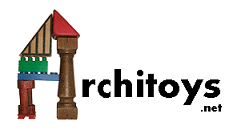
From simple stacking blocks for very young children to beautifully detailed wooden or artificial stone sets, stacking bricks are the simplest and most ubiquitous kind of architectural construction toy.
Some sets only contain cubic and rectangular bricks, but many contain arches, cylinders, triangular bricks and turned or carved columns. In late nineteenth century sets the latter can be very ornate and even some cheap sets from the mid-twentieth century have nicely detailed columns. Even more specialised and exotic parts exist. I have one set which contains flat, bevelled edge blocks which are intended to be used as a decorative string-course at eaves level.
Windows are unusual, but sets do exist with windows glazed in both glass (again generally late ninteenth century) or plastic. Some of the glass windows are painted to simulate stained glass.
Roofs are not provided for in most sets, particularly the simpler ones, but some do include triangular profile bricks - sometimes in two angles to allow a hipped roof to be built. Folded card roofs are also found sometimes. Otherwise, illustrations with the sets often suggest that roofs are to be indicated with triangular gables only. As a builder I never find this very satisfying!
Stone bricks may be in a variety of plain colours or have moulded and sometimes also coloured surface detail. Both Richter and early Lott's bricks were in plain colours but later Lott's bricks came in a number of embossed ranges.
Richter blocks come in an incredibly wide range of shapes and sizes including cubes, rectangles, cylinders, triangular and curved shapes, arches and half-arches. The stones were generally cream, red or dark blue. Roofs are built from the wide variety of curved and triangular blocks which include shapes to allow internal and external angles within a pitched or domed roof.
Lott's plain bricks come in a similar range of colours but only in cubic, rectangular and triangular shapes. The embossed sets, including a Tudor range, include blocks that indicate building material (brick, wood-framing), windows and doors. Some later ranges of Lott's bricks included plastic windows either as separate parts or incorporated into some of the bricks. Lott's roofs are always hinged cardboard, covered in a number of different printed papers to simulate slates, tiles etc.
The surface decoration on Lott's bricks is fairly shallow and restrained, with colour only on the raised parts. Other stone bricks are far more flamboyant. I have a set of blocks with deeply moulded parts suggesting stonework, wood-framing and pantiled roofs which builds wonderfully atmospheric models.
One can also include here the most recent idea for building sets - virtual bricks. There are a number of software packages which offer an on-screen equivalent of the traditional building block toy, of which one example is PC-BLOX produced by Vector Space.
|
|
|
|
|
|
|
|
|